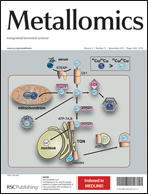Ni(ii) and Cu(ii) N4-ethylmorpholine citronellalthiosemicarbazonate: a comparative analysis of cytotoxic effects in malignant human cancer cell lines
Abstract
In this paper we report a study conducted with two analogous complexes, bis(N4-ethylmorpholine citronellalthiosemicarbazonate) nickel(II) and -copper(II) on four tumour cell lines (U937, HL60, SK-N-MC and HT29). All cell lines appear to be sensitive to both metal complexes, but while in U937, HL60 and SK-N-MC, apoptosis is the main mode through which cell death occurs, HT29 cells undergo necrosis. Among the cell lines which undergo apoptosis, SK-N-MC response is characterized by the intrinsic pathway, whereas U937 and HL60 involve both the intrinsic and the extrinsic pathways. The redox activity of the two complexes provides experimental evidence that they can modulate reactive oxygen species (ROS) production as a function of both the metal and the cell line used. Among the four cell lines, HL60 does not seem to give a significant response to exposure to both compounds. In the case of the nickel derivative, ROS generation is a relatively early event, and ROS could be the mediator leading to cellular damage. HT29 shows a remarkable and rapid ROS increase and a significant induction of membrane peroxidation that could be correlated to the onset of necrosis.


 Please wait while we load your content...
Please wait while we load your content...